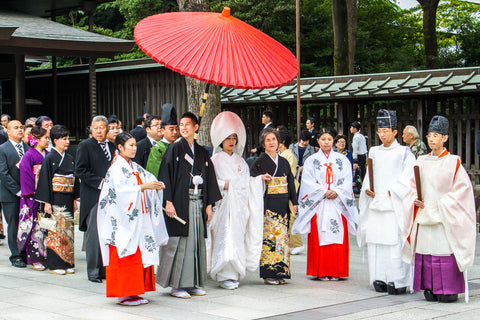Exploring the Traditions of Weddings in Japan
If you have never seen a Japanese wedding, you’re missing out on a truly traditional spectacle. Here’s your chance to become familiar with the customs, trends, and ceremonies of weddings in Japan.
Introduction to Weddings in Japan
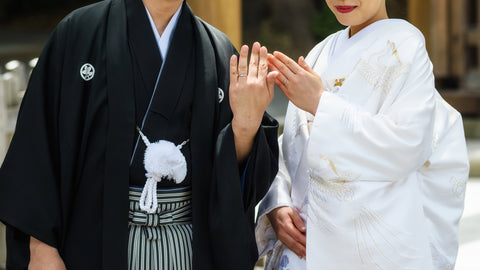
A wedding in Japan isn’t just the marriage of two people, but also the joining of two families. There is less emphasis on the religions of the bride and groom and more focus on the actual rites required for the union to be successful. Hence, it’s not uncommon to see non-Christian couples have a Christian or white wedding ceremony. Many of them don’t even use a Christian church as the venue.
Weddings in Japan can be either religious or non-religious. The religious weddings are mainly Shinto, Christian, or Buddhist. Christian-style weddings are the most popular. However, Shinto is considered Japan’s native religion, and it is the basis of most traditional wedding ceremonies in the country.
Modern Japanese weddings are special because they have a unique blend of tradition and freshness. Traditional marriage ceremonies still follow the rules of ancient culture but they incorporate additional elements from Western ceremonies. For example, shinto-style weddings these days involve the exchange of rings, which was never a part of the ceremony in ancient times.
Let’s take a deep dive into wedding customs in Japan, so you know what to expect if you find yourself attending one.
The Harmony of Traditional Japanese Wedding Ceremonies

The two main religions practiced in Japan are Shinto and Buddhism. Being an indigenous religion, Shinto is the most common, and its rites and customs are the basis for Japanese traditional weddings today.
A shinto wedding ceremony typically takes place in a shrine. The main officiant is the Shinto priest or kannushi, the person in charge of the shrine. During the event, the bride and groom dress in bridal kimonos, which are traditional Japanese wedding garments. It is tradition for the bride to wear a white or colored kimono while the groom wears a black kimono. The shinto wedding ceremony starts with the priest making a food offering to the gods. He then leads the gathering of close friends and family in prayer to notify the gods of the intended marriage and ask for their blessings.
Next up is the san-san-kudo (three-three-nine), a ritual in which the bride and groom each take three sips of sake from each of the three cups. At the end of san-san-kudo, the couple should be referred to as husband and wife. The priest makes a final offering and then the gathering moves on to eating and drinking. Some people exchange wedding rings during the event, which is typically a Western practice. Others don’t hold weddings in shrines but in hotels.
Buddhist weddings in Japan are quite different. The ceremony starts with the Heart Sutra recitation. What follows is a series of vows led by the priest and couple. The bride and groom exchange rings during their vows. San-san-kudo is also a popular practice at these weddings. Many of the customary rituals in these traditional weddings have changed in modern times. Let’s find out how!
Modern Japanese Wedding Ceremonies: A Contemporary Twist
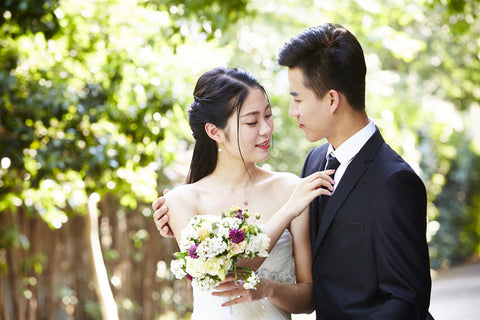
Modern Japan still honors traditional customs when it comes to wedding ceremonies. However, the rites have evolved to incorporate Western influences. Below are the biggest ways this has happened:
-
Venue: Decades ago, all traditional Japanese weddings had to be held in the shrine. Today, the ceremony can take place in hotels and ceremony halls.
-
Exchange of rings: Predominantly a Western culture, the exchange of rings between couples is now a big part of weddings in Japan.
-
Cutting of cakes: This is another adopted practice. However, the cake decorations are usually made of cherry blossoms (sakura). Also, it involves the use of a sword to cut the cake instead of a knife. The first cake slice is used as an offering to the gods.
-
Reception party: While Japanese weddings only have close friends and family in attendance, the reception allows for more people, including those who weren’t invited to the wedding ceremony.
-
Foreign venues and honeymoons: Destination weddings are now a thing in Japan. Couples hold their weddings at the foreign venues they picked for their honeymoons.
-
White weddings: Although less than 2% of Japanese people are Christians, Christian-style weddings are popular in the country. This is because they are considered fashionable. Some brides use white kimonos instead of Western-themed wedding gowns. We’ll reveal more about these gowns next.
Choosing the Perfect Japanese Wedding Kimono

The kimono embodies the ancient traditions and values of Japan, making it an important part of any style of Japanese wedding. The bride can wear a white wedding kimono called a uchikake or a similar garment called a shiromuku. Alternatively, she may wear a colored kimono or iro-uchikake. It’s common for Japanese brides to wear shiromuku at the main ceremony and iro-uchikake at the reception. Brides accessorize their kimono with traditional headpieces like the tsunokakushi (hide her horns) to discourage jealousy and the wataboshi domed hat to conceal her hairdo. Ancient custom also encourages the bride to hide a dagger in her rope to protect herself and her family. Below are a few tips to help you choose the perfect kimono wedding dress.
-
Understand the symbolism behind the color, embroidery, and materials of the kimono.
-
Short kimonos are great for casual venues like the beach and long kimonos are better for formal venues.
-
Don’t choose one unless you love the color.
-
We recommend that you make your kimono stand out from the dresses of the bridal party.
The Elegance of the White Wedding Gown in Japan

The color white symbolizes purity and death, which represents the end of the bride’s old life and the beginning of a new one. She is becoming a part of a new family and should be open to new ideas and values. This perception of the color white is the main reason for the popularity of bridal kimonos. It also allowed for the easy adoption of the white wedding gown in Japanese ceremonies after World War II, when Western influence was greatly accelerated.
Japanese women use white wedding gowns because of how it makes them feel and not because of any Christian obligation. After the largely televised royal wedding of Princess Diana to Prince Charles in 1981, people in Japan fell in love with church-style weddings. More televised weddings, pop culture, and the rise of social media have only increased their appeal in the last decades. Yearning for the white wedding dress experience has become so common that there are more Christian-style weddings than traditional Shinto weddings in Japan today.
The Role of the Bride and Groom in Japanese Weddings

Earlier, we mentioned that the bride wears a white or colored kimono while the groom wears a black one. For a Christian-style wedding, the bride can wear a white wedding gown and the groom a black tux. We also talked about their roles in the vow recitations and san-san-kudo. However, their responsibilities don’t stop there. Even before the wedding, the bride and groom have to organize a formal dinner for both their families to meet. Also, Japanese couples play a significant role in the planning of the marriage ceremony.
Although the couple receives gifts at the end of the ceremony, they’re also obligated to give out wedding favors, such as sweets, tableware, pastries, glassware, and towels. They also have to offer gifts to their parents. The responsibilities multiply when you consider other events like the wedding and afterparty. That is why all guests must play their part in making the couple’s big day a special one.
Wedding Guests: Etiquette and Traditions
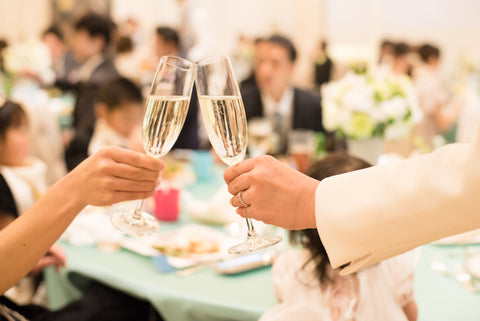
Are you a soon-to-be wedding guest in Japan? If so, you need insights into the expectations and etiquette of such a cultural event. Follow the guide below:
-
Responding to the Invitation: Remember to RSVP when you get an invite to the wedding. Avoid words and phrases related to cutting, splitting, or breaking when writing your reply, as they are taboo for the couple.
-
Gifting: You’re obligated to give goshugi, a special wedding money gift, even if you can’t attend the ceremony. Be sure to package the money in a special envelope called shugi-bukuro. Use new bills and only offer an odd-numbered amount. The standard amount is 30,000 yen, but work bosses and close family members pay 50,000 yen.
-
Dress codes and attire: You can wear a kimono to the wedding if you know how. Ladies should wear long gowns that don’t reveal their shoulders, while guys can come in a suit and tie. As a guest, avoid wearing white to a Japanese wedding.
-
Bringing a partner: Most Japanese weddings don’t make provisions for invitees to bring partners. If you do get to bring a plus-one, ensure it’s an official partner willing to offer their own goshugi.
-
Attending the reception and afterparty: The post-wedding events are usually more casual. You may need to bring a gift of 10,000 yen to the afterparty. Feel free to enjoy yourself while remaining polite and well-behaved. Avoid getting drunk at the party. Also, remember to take the gifts offered by the celebrants.
-
Saying thanks: After everything, don’t forget to send a thank-you card to the newlyweds.
The Significance of Wedding Ceremonies at Shinto Shrines

A modern Japanese wedding ceremony can take place anywhere, but no venue is as spiritual as a Shinto shrine. The rites performed at the shrine have been tagged “wedding before the kami,” which is an indication of the significance of the venue as kami refers to ancient Japanese spirits. The Shinto priests pray to the deities and ask them to bless the couple with peace, good fortune, and fertility. The priest also calls on specific Japanese gods like Izanagi and Izanami, asking them to make the marriage a harmonious one.
Festivities and Rituals: Understanding Japanese Wedding Parties

Let’s explore the various festivities and rituals that make up the Japanese wedding party, including the reception and the after-party traditions
-
Betrothal ceremony: Before the wedding, there’s a betrothal ceremony between the two families. It’s called Yuinou and heavily involves the exchange of gifts, including money.
-
Speeches: Family members and close friends give speeches during the reception.
-
Bouquet presentation: Newlyweds wait until the end of a Japanese wedding reception to present a large bouquet of flowers to their parents. It’s a form of honor and appreciation.
-
Bride letter presentation: After the bouquet presentation follows the handing of the letter from the bride to her parents.
-
Dancing: Receptions are typically formal, and dancing is usually reserved for the afterparty.
-
Outfit changes: Traditions encourage the couple to change outfits several times during the various ceremonies.
-
San-san-kudo: This is the sake-drinking rite involving the couple, their parents, and potential matchmakers.
The Exchange of San-San-Kudo: A Symbolic Wedding Ritual
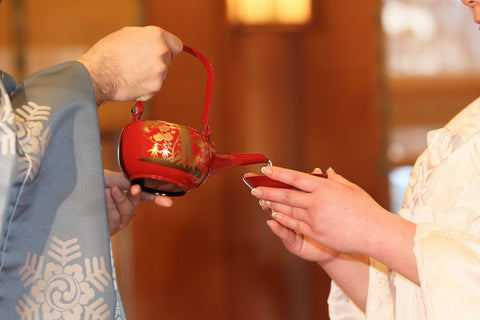
The san-san-kudo (three-three-nine) is a sacred Japanese rite involving sake, a type of alcoholic rice wine, and three cups. The ceremonial sake cups are called sakazuki and are stacked in a tier-format. The bride and groom sip from each of the cups three times. That’s nine sips in total for each person, hence the name: three-three-nine. You may have noticed at some point in this post that odd numbers (indivisible by 2) like 3 are considered fortunate for couples.
Back to the ceremonial rite. The first and smallest cup symbolizes their past; the second and medium cup represents their present; and the biggest cup refers to their future. After that, the next people to take sips are the groom’s parents, followed by the bride’s. In cases where the couple were linked through an ancient Japanese tradition, their matchmaker takes a sip last. The practice of san-san-kudo is no longer exclusive to traditional weddings, and you can find it at Western-themed events.
Incorporating Japanese Elements into Western Weddings
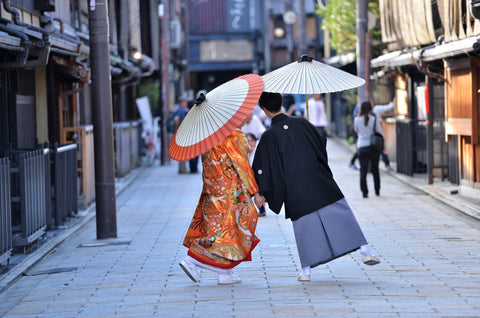
One way to add some uniqueness and culture to your western-style wedding is to incorporate Japanese elements. We’ve got some ideas you might love!
-
Serve Japanese dishes at the wedding. Your guests will love the exquisite taste of sushi, mochi, and other Japanese dishes when prepared correctly. This strategy is particularly effective when you have a lot of Japanese natives on your guest list.
-
Include a ceremonial sake-opening at the reception. Kagami Biraki is a ceremonial rite of opening and sharing a cask of sake. You can do this at the reception.
-
Wear kimonos to the events. If any of the couple is from Japan, then both can wear Japanese wedding kimono during the ceremony. Be sure to wear them properly while considering the symbolism and colors we mentioned earlier in this post.
-
Use cherry blossoms (sakura) as decorations. Sakura flowers make beautiful decorations. Feel free to adorn your wedding and reception halls with them. You can also include lanterns to make the sakura glow at night.
-
Play shamisen music at the reception. The melodies from the three-stringed instrument will impress your guests and add a touch of Japanese heritage to your wedding.
Photography and Memories: Capturing a Japanese Wedding
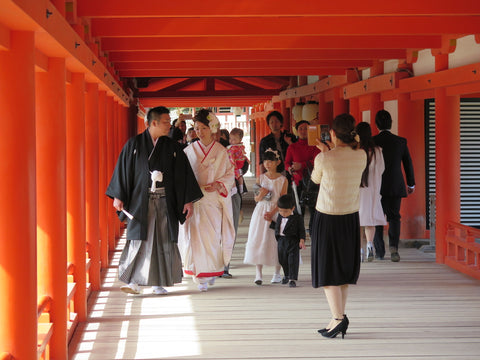
Like any elegant display of fashion, culture, emotions, and traditions, Japanese weddings deserve to be captured and preserved forever. Whether you’re a guest, family member, bride, or groom, take pictures of as many special moments as possible. These photos will tell a story to be cherished for generations to come. In a few years, when the buzz has died down and the attire has been put away, all that will remain are the memories, and photography is the gateway to accessing their intricate details.
Celebrating Love with Japanese Wedding Traditions
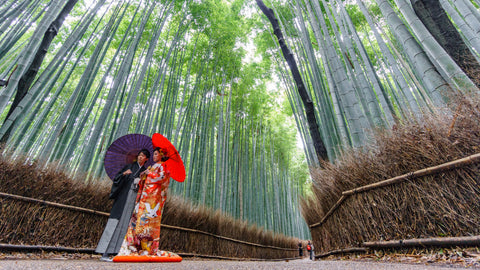
We love that Japanese wedding traditions are not restrictive. They encourage the bride and groom to celebrate their union with a blend of history and their personalities. Whether as a guest or participant, you should experience the magic of Japanese weddings whenever you get the chance. Our guide contains all of the information you need to make a great impression on others at the ceremonies. Feel free to explore the Bokksu Boutique collection of Engagement Gifts and get high-quality, traditional items.
Celebrate true love and companionship the Japanese way with Bokksu Boutique!
Author Bio






